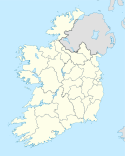Kilkenny
 | |||
| |||
| Państwo | |||
|---|---|---|---|
| Prowincja | Leinster | ||
| Hrabstwo | Kilkenny | ||
| Powierzchnia | 3,74 km² | ||
| Wysokość | 60 m n.p.m. | ||
| Populacja (2011) • liczba ludności | 8 711 | ||
| Nr kierunkowy | +353-56 | ||
| Kod pocztowy | R95 | ||
| Tablice rejestracyjne | KK | ||
| Strona internetowa | |||
Kilkenny (irl. Cill Chainnigh) – miasto nad rzeką Nore na południowym wschodzie Irlandii, w hrabstwie Kilkenny. Liczba mieszkańców wynosi 8711 (2011). Na przedmieściach żyje 13 518 osób (2011)[1].
W latach 1293–1408 oraz 1642–1648 w Kilkenny obradował Anglo-Normandzki parlament – Kilkenny było wtedy stolicą Konfederacji Rzymskokatolickiej oraz jednocześnie stolicą Irlandii. Status miasta Kilkenny otrzymało w roku 1609. Kilkenny, podzielone na dwa miasta (Irishtown oraz Englishtown), zostało zjednoczone w roku 1848.
Atrakcje turystyczne
Kilkenny to znany ośrodek turystyczny.
- Nad miastem górują średniowieczny zamek i katedra św. Kanizjusza, od której miasto wzięło nazwę (irlandzkie Cill Chainnigh oznacza: celę lub kościół Kanizjusza).
- W Zamku znajduje się Galeria Butlera, która skupia się na sztuce współczesnej[2]. Wstęp wolny (2019).
- W Kilkenny znajduje się także browar produkujący piwo o tej samej nazwie. Browar oferuje zwiedzającym wystawę o nazwie Smithwick's Experience.
- Najważniejszy obiekt religijny to Katedra św. Kanizjusza z 1285 r. wraz z 30-metrową okrągłą wieżą.
- Jeden z najstarszych kościołów w mieście to St. Mary's Church z 1205 r.
- Ważnym zabytkiem jest Black Abbey, opactwo dominikanów z 1225 r.
- Niedaleko Zamku znajduje się Narodowa Galeria Rękodzieła (The National Design & Craft Gallery)[3]. Wstęp wolny (2019).
- Atrakcją turystyczną jest też XVI w. tawerna The Hole in the Wall, obecnie nastrojowy klub muzyczny[4].
- W Kilkenny mieści się jeden z najstarszych irlandzkich pubów: Ketyler's Inn z 1324 r.[5]
Osoby związane z Kilkenny
Do miejscowego college'u uczęszczał twórca serii przygód Guliwera – Jonathan Swift oraz filozof George Berkeley.
Przypisy
- ↑ Census 2011 Population Classified by Area (ang.). [dostęp 2012-10-20].
- ↑ Butler Gallery | One of Ireland's Most Vibrant Contemporary Art Spaces, www.butlergallery.com [dostęp 2019-06-03] (ang.).
- ↑ Home | National Design & Craft Gallery, Kilkenny, Ireland, www.ndcg.ie [dostęp 2019-06-03] (ang.).
- ↑ Hole In the wall, www.holeinthewallpub.com [dostęp 2019-06-03] (ang.).
- ↑ Pubs in Kilkenny, Kyteler's Inn, Kilkenny, Ireland. Kilkenny Pubs, Going out in Kilkenny,Kilkenny Restaurants, Live Music Kilkenny, Traditional Irish Music, Trad Music, Night ..., www.kytelersinn.com [dostęp 2019-06-03] (ang.).
Bibliografia
- Irlandia. Adrian Wróbel, Piotr Thriel. Helion 2017
Media użyte na tej stronie
Autor: Trounce, Licencja: CC BY-SA 2.5
A panorama of Kilkenny city, county Kilkenny, Ireland, taken from about 4km west of the city.The church in the centre is St. Mary's cathedral (Roman Catholic).Just to the right of it is Kilkenny castle.The two mountains in the background are from left, Mt. Leinster (TV transmitter on top) and Blackstairs mountain. Where the plume of steam is rising is St. Francis abbey brewery, the home of Smithwick's ale and of course "Kilkenny" beer.To the left of the brewery with the round tower, is Kilkenny's second cathedral, St. Canice's (Church of Ireland [Episcopalian]).Taken on the 29th January 2006.
Autor: Wikimandia, Licencja: CC BY-SA 4.0
Arms of County Kilkenny, Ireland: Ermine, a fess party per pale, dexter sable three garbs argent, sinister quarterly 1st and 4th: argent, 2nd and 3rd: gules a fret or. Text per www.heraldry-wiki.com[1]: The fess contains the arms of two families, one Gaelic, the other Norman, thereby signifying the historic and harmonious fusion of these two great Irish traditions within the County. The silver garbs or sheaves on a black field represent Dermot MacMorrough, King of Leinster (Burke, Sir Bernard, The General Armory, London, 1884, p.645, gives the arms of "Mac Morogh, King of Leinster ... who surrendered his sovereignty to King Henry II of England in 1172" as Sable, three garbs or) while the gold fret on red is associated with the family of Den or de la Denn who, according to Samuel Lewis, were possessed of the Castle of Grenan near Thomastown. (See: Carrigan's History and Antiquities of the Diocese of Ossory and entitled "The Dens of Grenan"[2])









